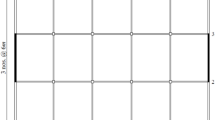Abstract
Indian Standard for seismic design of Reinforced Concrete (RC) frame buildings with Un-Reinforced Masonry (URM) Infills have undergone significant revisions in 2016 compared to its older version in 2002 and 1993, respectively. Two of the major revisions of BIS 13920-2016 are the inclusion of capacity design criteria to ensure strong-column weak-beam and selection of column dimension based on largest longitudinal beam rebar. The revised seismic design standard also recommends modeling guidelines for Un-Reinforced Masonry (URM) infill using the equivalent diagonal strut to take into account the complex infill-frame interaction. Under lateral loading, infills contribution to global strength and stiffness is often ignored for being treated as non-structural elements in general design practice. The present study attempts to evaluate the comparative seismic response of Special Moment Resisting Frame (SMRF) RC buildings with and without infills, designed with revised and older versions of Indian seismic standards. Capacity curves have been developed through nonlinear static pushover analysis. It has been observed that revised code provisions improve the structural performance in terms of stiffness, strength, inelastic displacement capacity, and eventually results in the desired ductile failure mechanism of the RC frames. However, considering the effect of infills as per the revised Indian standard has led to reduced inter-storey drift and ultimate inelastic deformation compared to the bare frame and the general design practice. It has been observed that the infill-frame interaction plays a key role in the overall performance as well as govern the failure mechanism of the structure as a whole.
Access this chapter
Tax calculation will be finalised at checkout
Purchases are for personal use only
Similar content being viewed by others
References
IS 1893 (Part1) 2016, Criteria for Earthquake Resistant Design of Structures, Bureau of Indian Standards.
IS 1893 (Part1) 2002; Criteria for Earthquake Resistant Design of Structures; Bureau of Indian Standards.
Haldar, P. and Y. Singh, (2009): Seismic performance and vulnerability of Indian code designed RC frame buildings. ISET journal of Earthquake Technology. 46(1): p. 29-45.
IS 13920 : 2016; Ductile Design and Detailing of Reinforced Concrete Structures Subjected Seismic Forces; Bureau of Indian Standards
Asteris, P.G., et al., Mathematical micromodeling of infilled frames: State of the art. Engineering Structures, 2013. 56: p. 1905-1921.
Asteris, P.G., et al., Mathematical Macromodeling of Infilled Frames: State of The Art. Journal of Structural Engineering, 2011. 137(12): p. 1508-1517.
Haldar, P., Seismic behavior and vulnerability of Indian RC frame buildings with URM infills, Doctoral Thesis, in Department of Earthquake Engineering. 2013, Indian Institute of Technology, Roorkee, Roorkee, India.
Haldar, P., Y. Singh, and D.K. Paul, Identification of seismic failure modes of URM infilled RC frame buildings. Engineering Failure Analysis, 2013. 33: p. 97-118.
EN 1998–1 (2004): Eurocode 8: Design of Structures for Earthquake Resistance – Part 1: General Rules, Seismic Actions and Rules for Buildings
NZS 3101–1 (2006): The Design of Concrete Structures; Authority of Development Sponsored By The Earthquake Commission (EQC) and Department of Building and Housing (DBH).
ACI 318–14 : Building Code Requirements for Structural Concrete; American Concrete Institute, 2014.
Computers and Structures Inc. (CSI), Integrated Software for Structural Analysis and Design, SAP2000, Berkeley, USA. . 2020.
IS 456 : 2000; Plain and Reinforced Concrete - Code of Practice; Burea of Indian Standard.
IS 875–1 (1987, Reaffirmed 2008): Code of Practice for Design Loads (Other Than Earthquake) For Buildings and Structures. Part 1: Dead Loads-Unit Weights of Building Materials and Stored Materials.
IS 875–2 (1987): Code of Practice for Design Loads (Other Than Earthquake) For Buildings And Structures, Part 2: Imposed Loads [CED 37: Structural Safety].
IS 13920 : 1993; Ductile Design and Detailing of Reinforced Concrete Structures Subjected Seismic Forces; Bureau of Indian Standards
Pisode, M., et al., Comparative Assessment of Seismic Fragility of RC Frame Buildings Designed for Older and Revised Indian Standards. ISET journal of Earthquake Technology, 2017. 54(1): p. 17-29.
ASCE/SEI 41–17, Seismic Evaluation and Retrofit of Existing Buildings, American Society of Civil Engineers, 2017.
Author information
Authors and Affiliations
Corresponding author
Editor information
Editors and Affiliations
Rights and permissions
Copyright information
© 2022 The Author(s), under exclusive license to Springer Nature Singapore Pte Ltd.
About this paper
Cite this paper
Kurmi, P.L., Haldar, P. (2022). Effect of Revised Seismic Design Provisions on Seismic Performance of RC Frame Buildings with and Without Infills. In: Ha-Minh, C., Tang, A.M., Bui, T.Q., Vu, X.H., Huynh, D.V.K. (eds) CIGOS 2021, Emerging Technologies and Applications for Green Infrastructure. Lecture Notes in Civil Engineering, vol 203. Springer, Singapore. https://doi.org/10.1007/978-981-16-7160-9_13
Download citation
DOI: https://doi.org/10.1007/978-981-16-7160-9_13
Published:
Publisher Name: Springer, Singapore
Print ISBN: 978-981-16-7159-3
Online ISBN: 978-981-16-7160-9
eBook Packages: EngineeringEngineering (R0)




